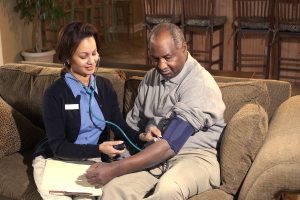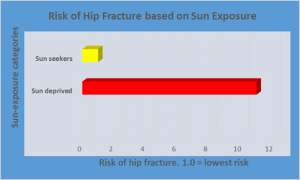A review published in the journal Nutrients discusses a great deal of research that indicates vitamin D provides protection against internal infection.[1] It regulates both innate (inborn, quick acting, short lived) immunity and acquired (promoted by response to an invasive organism and producing a long-lasting effect) immunity. 
The researchers extoll the virtues of vitamin D in increasing the strength of both forms of immunity, and state that vitamin D deficiency is associated with an increased risk for various infections, including HIV, respiratory tract and HCV infection. However, when discussing the efficacy of vitamin D supplementation, they state that “robust data from controlled trials investigating the use of vitamin D as a preventive or therapeutic agent are missing.”
Unfortunately, the researchers indicate that sun exposure would be a good way to obtain vitamin D in correct amounts, but then destroy that argument by stating that …”UVB radiation is also the main cause of human skin cancer, thus it is difficult, if not impossible, to make a general recommendation to expose the skin to the sun for sufficient vitamin D synthesis.”
They are wrong, of course. Common skin cancers cause very few deaths, and melanoma, the deadly cancer, is far less common in people who are regularly exposed to sunlight, compared to those who avoid the sun. Outdoor workers have about half the risk of contracting melanoma as do indoor workers.[2]
Another problem that the researchers have with sun exposure as a vitamin D source is this: People who live at high latitudes do not produce any vitamin D from sun exposure in the winter, because there is no UVB light at that time of year. My response to this is the following: Use UVB lamps or sunbeds. Such a suggestion would probably cause the authors of this researchers to melt down. I can hear them screaming “melanoma!” already. I would then direct them to a 20-year study from Sweden, which showed that women who used sunbeds during that 20 years had a 23% reduction in all-cause death risk compared to those who avoided sunbeds.[3] And, they were not at increased risk of melanoma. Also, the subjects in the study who avoided sun exposure were twice as likely to die of any cause compared to those who had the highest sun exposure.
At almost any place on earth, we now have either the sunshine or UVB lamps that can give us the vitamin D we need and the other photoproducts that protect us from myriad diseases, including various infections. It is a shame that too many fail to take advantage.
[1] Juliana de Castro Kroner, Andrea Sommer and Mario Fabri. Vitamin D Every Day to Keep the Infection Away? Nutrients 2015, 7, 4170-4188.
[2] Godar D, Landry, R, Lucas, A. Increased UVA exposures and decreased cutaneous Vitamin D3 levels may be responsible for the increasing incidence of melanoma. Med Hypotheses 2009;72(4):434-43.
[3] Pelle G. Lindqvist, Elisabeth Epstein, Mona Landin-Olsson, Christian Ingvar, Kari Nielsen, Magnus Stenbeck & Håkan Olsson. Avoidance of sun exposure is a risk factor for all-cause mortality: results from the Melanoma in Southern Sweden cohort. J Intern Med. 2014 Jul;276(1):77-86.
Hypertension, or chronic high blood pressure, is determined by the amount of blood the heart pumps and the amount of resistance to blood flow in the arteries. The more blood the heart pumps and the tighter the arteries, the higher the blood pressure.[1] The top number on a blood-pressure measurement, stated in millimeters of mercury (mm/Hg), is called systolic pressure, and the lower number is called diastolic pressure. Hypertension is defined as having a blood pressure > 140/90 mm/Hg.  Thirty-one percent of US adults are hypertensive.[2] Hypertension can damage arterial walls and can eventually lead to an increased risk of death from heart disease, heart failure, and other arterial diseases. It is also associated to a higher risk of kidney disease, irregular heart rhythms, osteoporosis, cognitive dysfunction, painful intercourse and stroke.[3] Conventional textbook theory holds that blood pressure is regulated by the brain, blood vessels, or kidney, but recent evidence suggests it could be regulated in the skin, and sun exposure plays a role in controlling hypertension.[4]
Thirty-one percent of US adults are hypertensive.[2] Hypertension can damage arterial walls and can eventually lead to an increased risk of death from heart disease, heart failure, and other arterial diseases. It is also associated to a higher risk of kidney disease, irregular heart rhythms, osteoporosis, cognitive dysfunction, painful intercourse and stroke.[3] Conventional textbook theory holds that blood pressure is regulated by the brain, blood vessels, or kidney, but recent evidence suggests it could be regulated in the skin, and sun exposure plays a role in controlling hypertension.[4]
One of the earlier studies of hypertension and sun showed hypertension increased linearly at increasing distances from the equator.[5] One study of hypertensive subjects shows that blood pressure levels average 165/90 in winter but 134/74 in the summer, and both stroke and heart attack rates double in the winter.[6] Even in children, blood pressure is higher in winter than summer.[7] This, of course, is indicative of a protective role of sun exposure on hypertension.
UVB light treatments with sun lamps have also been shown to substantially lower blood pressure in 24 hours, and over six weeks to raise serum 25(OH)D levels of vitamin D by 162%, while lowering both systolic and diastolic pressure by six points.[8]
However, it is important to again mention that there is another important player in the relationship between hypertension and sun. Ultraviolet A (UVA) light (part of sunlight) stimulation of the skin causes the release of nitric oxide (NO) from pre-formed stores of NO in the skin. NO is a potent vasodilator, and when released into the arteries by UVA stimulation, causes increased blood flow and lowered blood pressure.[9], [10]
Safe sun exposure, along with plenty of vegetable and fruit consumption, may enable you to say goodbye to blood-pressure problems.
[1] Mayo Clinic Diseases and Conditions: High blood pressure (hypertension). http://www.mayoclinic.org/diseases-conditions/high-blood-pressure/basics/definition/con-20019580 (accessed January 5, 2016).
[2] Fields LE, Burt VL, Cutler JA, Hughes J, RoccellaEJ, Sorlie P. The burden of adult hypertension in the United States 1999–2000: a rising tide. Hypertension. 2004;44:398–404.
[3] Ann Pietrangelo. Healthline 2014 http://www.healthline.com/health/high-blood-pressure-hypertension/effect-on-body (accessed January 4, 2016).
[4] Johnson RS, Titze J, Weller R. Cutaneous control of blood pressure. Curr Opin Nephrol Hypertens. 2016;Jan25(1):11-5.
[5] Rostand SG. Ultraviolet light may contribute to geographic and racial blood pressure differences. Hypertension. 1997 Aug;30(2 Pt 1):150-6.
[6] Charach G, Rabinovich PD, Weintraub M. Seasonal changes in blood pressure and frequency of related complications in elderly Israeli patients with essential hypertension. Gerontology. 2004 Sep-Oct;50(5):315-21
[7] Polat M, Akil I, Yuksel H, Coskun S, Yilmaz D, Erguder I, Onag A. The Effect of seasonal changes on blood pressure and urine specific gravity in children living in Mediterranean climate. Med Sci Monit2006;12:CR186-90.
[8] Krae R, Bühring M, Hopfenmüller W, Holick MF, Sharma AM. Ultraviolet B and blood pressure. Lancet 1998;352:709-10.
[9] Liu D, Fernandez BO, Hamilton A, Lang NN, Gallagher JM, Newby DE, Feelisch M, Weller RB. UVA irradiation of human skin vasodilates arterial vasculature and lowers blood pressure independently of nitric oxide synthase. J Invest Dermatol. 2014 Jul;134(7):1839-46.
[10] D Liu, BO Fernandez, NN Lang, JM Gallagher, DE Newby, M Feelisch and RB Weller. UVA lowers blood pressure and vasodilates the systemic arterial vasculature by mobilization of cutaneous nitric oxide stores. Photobiology Abstract # 1247 May 2013.
 In research on rheumatoid arthritis, involving studies done on nurses, an interesting result emerged.[1] It was found that among nurses 30-55 years of age who were assessed in 1976, and followed until 2008, there was an inverse association between sun exposure and the risk of rheumatoid arthritis. Those who were exposed to the greatest sun exposure had a 21% reduced risk of the disease. However, among nurses 25-42 years of age who were assessed in 1989 and followed until 2008, rheumatoid arthritis was not associated with greater sun exposure.
In research on rheumatoid arthritis, involving studies done on nurses, an interesting result emerged.[1] It was found that among nurses 30-55 years of age who were assessed in 1976, and followed until 2008, there was an inverse association between sun exposure and the risk of rheumatoid arthritis. Those who were exposed to the greatest sun exposure had a 21% reduced risk of the disease. However, among nurses 25-42 years of age who were assessed in 1989 and followed until 2008, rheumatoid arthritis was not associated with greater sun exposure.
The authors of the researchers offered an explanation regarding the disparate results. They felt that the greater use of sunscreen among the younger subjects
may have made the difference.
I agree with that idea. Sunscreen would have decreased the availability of vitamin D production, which may have lead to the lack of a protective effect on rheumatoid arthritis among the younger nurses.
Rheumatoid arthritis is a disease which causes chronic inflammation of the joints, the tissue around the joints and even in certain organs in the body.[2] It is an autoimmune disease such as lupus, multiple sclerosis and seasonal vitamin D declines may trigger it.[3] Vitamin D is an anti-inflammatory hormone and declines in vitamin D levels, of course, are a result of decreasing sun exposure in colder seasons.
Arthritic joints carry another devastating side effect. Hip replacement surgery is often prescribed for arthritic conditions, and those people who go through total-hip-replacement procedures are 4.7 times as likely to have an ischemic stroke, and 4.4 times as likely to have a hemorrhagic stroke in the first two weeks post surgery.[4] Those stroke risks remain elevated for 6-12 weeks. The term “ischemic” means producing a local deficiency of blood supply by obstructing blood flow.
I would be remiss if I did not also mention the transcendent importance of anti-inflammatory nutrition program. Sunlight is important but what you eat is critical. I would suggest that you google “anti-inflammatory diet.” Learn which foods (primarily fruits and vegetables) will help to decrease or prevent the inflammation that leads to RA. In the meanwhile, enjoy some safe, non-burning sunbathing.
[1] Arkema EV, Hart JE, Bertrand KA, Laden F, Grodstein F, Rosner BA, Karlson EW, Costenbader KH. Exposure to ultraviolet-B and risk of developing rheumatoid arthritis among women in the Nurses’ Health Study. Ann Rheum Dis. 2013 Apr;72(4):506-11
[2] Medicinenet.com. Definition of rheumatoid arthritis. http://www.medterms.com/script/main/art.asp?articlekey=5354.
[3] Cutolo M, Paolino S, Sulli A, Smith V, Pizzorni C, Seriolo B. Vitamin D, steroid hormones, and autoimmunity. Ann N Y Acad Sci. 2014 May;1317:39-46.
[4] Lalmohamed A, Vestergaard P, Cooper C, de Boer A, Leufkens HG, van Staa TP, de Vries F. Hip replacement surgery and stroke. Stroke 2012;43(12):3225-9.
A recent sunshine article in the UK online newspaper, The Mail, led with the headline, “Sunshine breaks could mean better mental health.” It then went on to describe how many shift workers, as well as other residents of the UK, are deficient in vitamin D.[1] Quoting from research published in the Journal BMC Public Health,[2] the article stated that about 91% of residents are at least insufficient in vitamin D.
Vitamin D deficiency of that extent is a health crisis, of that there is no doubt. It is also a surety that the way to combat vitamin D deficiency is by taking “sunshine breaks.” However, it is misleading to assume it is vitamin D deficiency that is responsible for the entire problem with mental health and other diseases as they relate to sun exposure. Consider the fact that lack of sunshine deficiency also causes problems beyond vitamin D deficiency. For example, the natural 24-hour cycles, called circadian rhythms, are desynchronized by lack of sunshine in the morning. This causes us to feel out of synch and to be more susceptible to many diseases including cancer.
Remember that sun exposure also leads to the production of serotonin,[3] endorphin,[4] dopamine,[5] and BDNF,[6] all of which have a positive effect on mood and mental health.
Sunshine is vital to mental and physical health, and that health is not due to vitamin D alone. Take a holistic view of the importance of sunshine.
[1] http://www.nwemail.co.uk/news/Sunshine-breaks-could-mean-better-mental-health-88b00574-032c-4467-846c-1eff0514d4e8-ds
[2] Sowah D, Fan X, Dennett L, Hagtvedt R, Straube S. Vitamin D levels and deficiency with different occupations: a systematic review. BMC Public Health. 2017 Jun 22;17(1):519.
[3] Lambert GW, Reid C, Kaye DM, Jennings GL, Esler MD. Effect of sun and season on serotonin turnover in the brain. Lancet. 2002 Dec 7;360(9348):1840-2.
[4] Asta Juzeniene and Johan Moan. Beneficial effects of UV radiation other than via vitamin D production: Dermato-End Holick, M. The UV Advantage 2. Ibooks 2003, New York. Ocrinology 2012;4(2):109–117.
[5] Holick, M. The UV Advantage 2. Ibooks 2003, New York.
[6] Molendijk ML, Haffmans JP, Bus BA, Spinhoven P, Penninx BW, Prickaerts J, Oude Voshaar RC, Elzinga BM. Serum BDNF concentrations show strong seasonal variation and correlations with the amount of ambient sun. PLoS One. 2012;7(11):e48046.
Sun exposure reduces risk of heart disease. High cholesterol levels are associated with vascular diseases such as heart disease, ischemic stroke and intermittent claudication (an occlusion of the arteries of the legs that leads to pain and disability). The authors of a recent study compared the effects of vitamin D supplementation with sun exposure to determine which was more effective in reducing risk factors.[1] A group of individuals with insufficient serum vitamin D levels was divided into two groups with different experimental protocols: one was treated with sun exposure to the arms and face between 11 AM and 3 PM and the other was treated with 1,000 IU of vitamin D. A third group had “normal” vitamin D levels and served as a control (no treatment group). Total cholesterol levels and its components of cholesterol, HDL and LDL, were also measured to determine the positive (or negative) effects of the two treatment protocols.
The results were enlightening. Both experimental groups had significant increases in vitamin D. However, the results with cholesterol varied. A significant decrease in total cholesterol was noted in the sun exposure group, and HDL and LDL also decreased in the sun-exposure group. However, in the vitamin D-supplement group, a significant increase was noted in in total cholesterol. HDL also increased significantly, and LDL increased non-significantly.
In other words, vitamin D supplementation could actually lead to an increased risk of vascular diseases by raising total cholesterol, whereas sun exposure is protective against those diseases. So the takeaway is that there is no substitute for the sun when it comes to providing some protection against vascular diseases.
There are those people who worry that melanoma risk may be increased by regular sun exposure. However, we have mentioned many time in this blog that melanoma is much more common among those who work indoors than those who work outdoors. It should also be mentioned that vascular diseases kill far more people than skin cancer. Dr. Richard perhaps said it best:
“Sunlight may have beneficial cardiovascular effects, independently of Vitamin D production. Vitamin D could, in these circumstances, act as a marker for sunlight exposure and its postulated beneficial effects. These recent human data show the physiological relevance of photorelaxation. High blood pressure is the leading cause of disability-adjusted life years lost worldwide and as a risk factor underlies 18% of all deaths.” Weller further noted: “The action spectrum of nitrite release shows ultraviolet B is also involved in nitrite reduction to Nitric Oxide, and thus sunlight may be more effective than a pure UVA source.” He concluded: “the prevalence of cardiovascular and cerebrovascular deaths is around 100 times higher than those from skin cancer. Interventions leading to small changes in the incidence of cardiovascular disease are thus of greater benefit to the health of the public even than large changes in skin cancer incidence.”[2]
Safely embrace the sun and your heart, brain and blood vessels will love you for it!
[1] Patwardhan VG, Mughal ZM, Padidela R, Chiplonkar SA, Khadilkar VV, Khadilkar AV. Randomized Control Trial Assessing Impact of Increased Sunlight Exposure versus Vitamin D Supplementation on Lipid Profile in Indian Vitamin D Deficient Men. Indian J Endocrinol Metab. 2017 May-Jun;21(3):393-398.
[2] Weller R. The health benefits of UV radiation exposure through vitamin D production or non-vitamin D
Pathways. Blood pressure and cardiovascular disease. Photochem. Photobiol. Sci. 2016.
Sun exposure and health… by Dr. Marc Sorenson, Sunlight Institute…
Lack of vitamin D, which is produced by sun exposure, leads to rickets, osteoporosis, osteomalacia and other bone diseases. In addition, research well after the first discovery of vitamin D has shown that vitamin D deficiency and sunlight deprivation also lead to many cancers, heart disease and multiple additional maladies. Now, as the world has modernized, the population is moving indoors, and even in the areas that are sunny throughout the year, sunlight exposure and vitamin D deficiency is increasing, both in rural and urban populations. The bones become so weakened without regular sun exposure, that the slightest movement may cause a fracture. As an example, the mother of an acquaintance of mine—a woman who avoided the sun—turned over in bed one night and broke her hip. Osteoporosis often destroys all quality or life for those who suffer it.
The importance of the sun in maintaining and producing strong bones has been known since antiquity. Dr. Richard Hobday, author of The Healing Sun, writes the following comments along with a history in an online article.[1] “Traditionally, sunlight deprivation has been linked with weak or brittle bones. One of the earliest references to this was made more than two thousand years ago by the Greek historian Herodotus (480-425 BC), who noted a marked difference between the remains of the Egyptian and Persian casualties at the site of battle of Pelusium which took place in 525 BC:
‘At the place where this battle was fought I saw a very odd thing, which the natives had told me about. The bones still lay there, those of the Persian dead separate from those of the Egyptian, just as they were originally divided, and I noticed that the skulls of the Persians were so thin that the merest touch with a pebble will pierce them, but those of the Egyptians, on the other hand, are so tough that it is hardly possible to break them with a blow from a stone. I was told, very credibly, that the reason was that the Egyptians shave their heads from childhood, so that the bone of the skull is indurated by the action of the sun — this is why they hardly ever go bald, baldness being rarer in Egypt than anywhere else. This, then, explains the thickness of their skulls; and the thinness of the Persian’s skulls rests upon a similar principle: namely that they have always worn felt skull -caps, to guard their heads from the sun.’
Herodotus, ‘The Histories’”
And here is a perhaps the transcendent study on hip fracture and sun exposure: research in Spain showed that women who were sun seekers had only about one-eleventh the risk of hip fracture as those who stayed indoors[2] (See the chart below).
That is very powerful evidence of the efficacy of sun in preventing weak bones. In stark contrast to this research are studies done on women who completely avoid the sun and suffer from osteomalacia. Osteomalacia is a soft-bone disease known as adult rickets, resulting from severe vitamin D deficiency, which deficiency prevents bone from properly mineralizing. Women who seldom go outdoors, or who are nearly always fully covered with clothing, have an extremely high incidence of osteomalacia at a very young age, even if they live in geographical areas with abundant sunlight.[3] [4] If one is never exposed to the available sun, the sun will not be able to produce its beneficial effects on the body, so one may as well live at the North Pole.
Sunbed use also is associated with stronger bones and higher vitamin D levels. An excellent study compared 50 people who used sunbeds regularly with 106 who did not.[5] The sunbed group had 90% higher vitamin D, significantly higher bone density and lower PTH levels (high PTH levels are associated with lower bone mass). The users had healthful vitamin D levels of 46 ng/ml [115 nmol/L] compared to only 24 ng/ml [60 nmol/L] for those who did not regularly use sunbeds.
Scientists at one time believed that sunlight and vitamin D were good only for preventing rickets, osteoporosis and other bone weaknesses. That belief has been supplanted by myriad research studies that show the efficacy of both sun exposure and vitamin D repletion on protection against numerous additional diseases. Nevertheless, we should never forget the extraordinary, never-changing value of sun exposure to maintaining a strong skeleton well into old age.
[1]Richard Hobday. The Healing sun: Sunlight, Brittle Bones, and Osteoporosis. http://sunlightenment.com/the-healing-sun-sunlight-brittle-bones-and-osteoporosis/. (accessed February 5, 2016)
[2] Larrosa M, Casado E, Gómez A, Moreno M, Berlanga E, Ramón J, Gratacós J. Vitamin D deficiency and related factors in patients with osteoporotic hip fracture. Med Clin (BARC) 2008;130:6-9.
[3] Sahibzada AS, Khan MS, Javed M. Presentation of osteomalacia in Kohistani women. J Ayub Med Coll Abbottabad 2004;16:63-5
[4] Al-Jurayyan NA, El-Desouki ME, Al-Herbish AS, Al-Mazyad AS, Al-Qhtani MM. Nutritional rickets and osteomalacia in school children and adolescents. Saudi Med J 2002;23:182-85.
[5] Tangpricha V, Turner A, Spina C, Decastro S, Chen TC, Holick MF. Tanning is associated with optimal vitamin D status (serum 25-hydroxyvitamin D concentration) and higher bone mineral density. Am J Clin Nutr. 2004 Dec;80(6):1645-9.
By Marc Sorenson, EdD for sun exposure and health…
The Vitamin D Society of Canada has just released one of the best articles on the relationship of sun exposure and its potential for vitamin D production. Sun exposure is the natural way to obtain your essential vitamin D, and of course provides other essential photoproducts such as nitric oxide, serotonin, endorphin and BDNF.
Here is the press release from the Vitamin D Society, in full:
NEWS RELEASE
For Immediate Distribution
TORONTO, Ont (April 4, 2017) – The daylight hours are getting longer, the sun is getting stronger and summer is just around the corner. Make this the year that you optimize your vitamin D levels through effective sun exposure. Enjoy the health benefits and disease prevention from optimal vitamin D levels and learn to control your risks from sun exposure.
Vitamin D is made naturally in your body when UVB rays from the sun convert cholesterol in your skin to pre-vitamin D3. We make about 90% of our vitamin D from UVB sun exposure. UVB rays are short and only reach the earth when the sun is directly above us. We can’t make vitamin D in the winter in Canada because the sun is at too low of an angle and the UVB rays are absorbed in the atmosphere.
You make vitamin D in Canada between the months of May and October. The best time for exposure is around midday, between 10am and 2pm, when the UV index is above 3 and your shadow is shorter than your height. The further you get from noon, the lower the amount of vitamin D you’ll make. The sun’s visible light may penetrate through glass, but UVB light will not; therefore you will not make vitamin D.
Full body sun exposure at non-burning levels can create between
10,000-25,000 IU of vitamin D in your skin. You can never get too much vitamin D from the sun as your skin self regulates, whereas ingesting vitamin D does not have the same control. In addition, vitamin D that you make from the sun lasts twice as long in your body as vitamin D taken through supplements or food.
Statistics Canada reports that Canadian vitamin D levels have dropped by 10% over the past six years. The root cause of this decrease is lower sun exposure. People are just not getting outside around midday in the summer and making vitamin D, and when they are outside they are using sunscreen, which if applied correctly prevents 95%+ of vitamin D production.
In Canada, 12 million Canadians (35%) have vitamin D blood levels below the recommendations from Health Canada. This puts these people at a higher risk for several diseases, including cardiovascular disease, cancer, osteoporosis, diabetes, multiple sclerosis, Alzheimer’s disease and many more. In fact, a study completed in 2016 reported that if Canadians increased their vitamin D levels to the recommended level of 100 nmol/L, we would save $12.5B in healthcare costs and 23,000 premature deaths annually.
A recent study reported that women who avoided the sun have twice the risk of all cause death. The authors said that “avoidance of sun exposure is a risk factor for death of a similar magnitude as smoking.”
Skin cancer is a concern and risk of sun exposure must be managed and balanced with the benefits from vitamin D and other photoproducts. Research has shown that people with higher sun exposure such as outdoor workers, who have 3-10 times the sun exposure as indoor workers, have a lower incidence of melanoma. The National Cancer Institute reports that
melanoma risk is increased as a result of intermittent acute sun
exposure leading to sunburn. People who are a skin type 1, with white or very pale skin colour, red or blonde hair colour and who always burn and never tan, should severely limit their sun exposure.
The Vitamin D Society offers the following tips:
– Know your own skin and skin type. Don’t burn. Never overexpose yourself.
– Acclimatize or condition your skin for sun exposure by gradually
building or lengthening exposure times as your skin begins to tan to reduce your risk of burning
– Prevent burning and overexposure when required through the use of hats, clothing, shade and sunscreens.
– For vitamin D, get sun exposure at midday, between 10 am and 2 pm, when the UV index is above 3 and your shadow is shorter than your height.
– Expose more skin for a shorter period of time to generate more vitamin D while reducing your risk of overexposure.
It’s important to manage the risk and enjoy the rewards of moderate sun exposure for good health. Cancer Research UK, through the Consensus Vitamin D Position Statement, offers the following recommendation:
“Enjoying the sun safely, while taking care not to burn, can help provide the benefits of vitamin D without unduly raising the risk of skin cancer.”
“This advice may go against what current health organizations
recommend,” says Perry Holman, Executive Director of the Vitamin D Society. “They typically recommend you stay out of the sun at midday and use sunscreen when outdoors. But this would reduce your potential vitamin D production and does not consider the benefits as well as the risks of sun exposure on overall health. You need to have balance.”
About the Vitamin D Society:
The Vitamin D Society is a Canadian non-profit group organized to increase awareness of the many health conditions strongly linked to vitamin D deficiency; encourage people to be proactive in protecting their health and have their vitamin D levels tested annually; and help fund valuable vitamin D research. The Vitamin D Society recommends people achieve and maintain optimal 25(OH)D blood levels between 100 –
150 nmol/L (Can) or 40-60 ng/ml (USA).
To learn more about vitamin D, please visit www.vitamindsociety.org
For more information, please contact:
Melissa Andrade, Enterprise Canada 905-346-1230
mandrade@enterprisecanada.com.
THIS PRESS RELEASE CONTAINS MUCH OF WHAT YOU NEED TO KNOW ABOUT VITAMIN D, SUN EXPOSURE AND HEALTH. Please read it carefully, as it could save your life.
Marc Sorenson.
Sun Exposure and health by Marc Sorenson, EdD…
A very interesting study has been completed in a remote area of South America.
An indigenous tribe from the remote Bolivian Amazon jungle, known as the Tsimane, has been found to have the world’s healthiest arteries.[1] People there survive on a diet low in saturated fats and high in non-processed foods. One of the researchers stated that “Our study shows that the Tsimane indigenous South Americans have the lowest prevalence of coronary atherosclerosis of any population yet studied.”
Here are some of the lifestyle habits and facts regarding the Tsimane.
- The diet is fiber rich.
- The diet is approximately 75% non-processed carbohydrates. Isn’t that supposed to make us fat?
- The diet includes rice, plantain (a type of banana), corn, nuts, and a very small amount of animal meat.
- Smoking is almost non-existent.
- Only three per cent of the people had moderate to high heart disease risk; two-thirds of them over 75 years of age had virtually no risk. The article states that only 14% of Americans had no risk, and that half had a moderate or high risk—about 5 times higher than the Tsimane.
- Men spend six to seven hours of their day being physically active, whereas women spend four to six hours. This, of course, means plenty of sun exposure.
During most of my professional career, I have advised people to live on this type of diet, but without the meat or any other animal product. In addition we helped them to exercise several hours daily outside. During that time, my wife and I have observed that people have recovered from diabetes, heart disease, arthritis and other maladies. That is no surprise, considering this new research and many other studies. Vitamin D and nitric oxide, both photoproducts, are exceptionally important to human health, but when it comes to heart disease, nitric oxide is probably the operative photoproduct. Here is a quote from Dr. Richard Weller, a common-sense dermatologist and great researcher:
“Sunlight may have beneficial cardiovascular effects, independently of Vitamin D production. Vitamin D could in these circumstances act as a marker for sunlight exposure and its postulated beneficial effects.” “These recent human data show the physiological relevance of photorelaxation. High blood pressure is the leading cause of disability adjusted life years lost worldwide and as a risk factor underlies 18% of all deaths.” The study noted: “The action spectrum of nitrite release shows that ultraviolet B is also involved in nitrite reduction to Nitric Oxide, and thus sunlight may be more effective than a pure UVA source.” The study concluded: “the prevalence of cardiovascular and cerebrovascular deaths is around 100 times higher than those from skin cancer. Interventions leading to small changes in the incidence of cardiovascular disease are thus of greater benefit to the health of the public even than large changes in skin cancer incidence.”[2]
The Tsimane, therefore, are living (unknowingly) an almost perfect lifestyle for optimal health. To stay well, it is imperative that we do the same, although we don’t need quite that much sun exposure. Remember to build up a tan and be safe in the sun.
[1] http://www.mirror.co.uk/science/proof-modern-life-really-kill-10047382
[2] Weller R. The health benefits of UV radiation exposure through vitamin D production or non-vitamin D pathways. Blood pressure and cardiovascular disease. Photochem. Photobiol. Sci. 2016, DOI: 10.1039/C6PP00336B.
 By Marc Sorenson, EdD, for sun exposure.
By Marc Sorenson, EdD, for sun exposure.
According to a new study, people with MS feel better when they spend more time in the sunshine.[1] Not only will they feel better, but they will have lower rates of fatigue, and a slower progression to disability. None of this should be a surprise, since similar results have been reported for decades. For example, in 1922 Dr. Charles Davenport wrote a paper entitled, “Multiple Sclerosis from the standpoint of geographic distribution and race.[2] He analyzed the MS rate of military draftees and compared it to their states of origin. The highest rates were found in men who grew up in Michigan, Wisconsin, and the extreme northwest—all areas with low sun availability. There were few cases of MS among those who grew up in southern states, where sun exposure is abundant. He also noted that those from urban areas, which have lower sun availability than rural areas, had 50% higher MS rates than those from rural areas. Similar studies confirm that relationship.[3] [4]
Another interesting research paper demonstrated that sun exposure, while obviously being critical in the production of vitamin D, had its own profound influence in lessening the degeneration of nerves (neurodegeneration) in those with MS.[5] By measuring whole brain volume (WBV) and grey-matter volume (GMV) by magnetic resonance imaging (MRI), the scientists determined that greater summer sun exposure predicted greater WBV and GMV in MS patients. Interestingly though, when vitamin D levels were measured, they had no influence on the positive effects of sun exposure with WBV or GMV. The researchers concluded: “Sun exposure may have direct effects on MRI measures of neurodegeneration in MS, independently of vitamin D.”
Be sure that you soak up your share of sunlight, without burning of course. It may indeed save your life!
[1] https://multiplesclerosisnewstoday.com/2017/02/24/actrims2017-sun-exposure-may-lower-fatigue-slow-disability-progression-in-ms/
[2] Davenport, C. Multiple Sclerosis from the standpoint of geographic distribution and race. Arch Neurol Psychiatry 1922;8:
[3] Acheson ED, Bachrach CA, Wright FM. Some comments on the relationship of the distribution of multiple sclerosis to altitude, solar radiation and other variables. Acta Psychiat (Scand) 1960;35 (suppl 147):132-47. 51-58
[4] Norman JE Jr, Kurtzke JF, Beebe GW. Epidemiology of multiple sclerosis in USA veterans: 2. Latitude, climate, and risk of multiple sclerosis. J Chron Dis 1983;36:551-59
[5] Zivadinov R, Treu CN, Weinstock-Guttman B, Turner C, Bergsland N, O’Connor K, Dwyer MG, Carl E, Ramasamy DP, Qu J, Ramanathan M. Interdependence and contributions of sun exposure and vitamin D to MRI measures in multiple sclerosis. J Neurol Neurosurg Psychiatry. 2013 Oct;84(10):1075-81.
Benegits of sun exposure by Marc Sorenson, EdD…
For those who follow my writings, it should now be obvious that the risk of melanoma is decreased by regular sun exposure, and that the evidence for the health benefits of safe sun becomes clearer by the day. I opine that millions of lives could be saved yearly by regular, non-burning sun exposure for the entire population.
Another benefit of moderate sun exposure, or other ultraviolet radiation (UVR), is that it does not cause sufficient DNA damage to prevent efficient repair. A study published in the British Journal of Dermatology reviewed the impact of repeated low level sunlight exposures on vitamin D status and DNA damage/repair in light and brown skinned individuals.[1] The UVR doses were equivalent to 13-17 minutes of midday exposure in the UK. The study reported that no evidence existed for these low-level exposures leading to accumulated DNA-damage, indicating that any damage was quickly repaired. The research also showed that the exposures led to sufficient vitamin D levels in the participants. In addition, it has been shown that “Regular exposure to UV leads to an almost complete disappearance of DNA damage in the basal and suprabasal layers of the epidermis, where the initiating of skin cancer occurs.[2] It is no wonder that regular sun exposure is associated with less melanoma! Soak up some moderate, non-burning sun!
[1] Felton SJ, Cooke MS, Kift R, Berry JL, Webb AR, Lam PMW, de Gruijl FR, Vail A, and Rhodes LE. Concurrent beneficial (vitamin D production) and hazardous (cutaneous DNA damage) impact of repeated low-level summer sunlight exposures. Br J Dermatol. 2016 Jul 14. doi: 10.1111/bjd.14863. [Epub ahead of print]
[2] van der Rhee H, de Vries E, Coomans C, van de Velde P, Jan Willem Coebergh JW. Sunlight: For Better or For Worse? A Review of Positive and Negative Effects of Sun Exposure. Cancer Research Frontiers. 2016 May; 2(2): 156-183.


